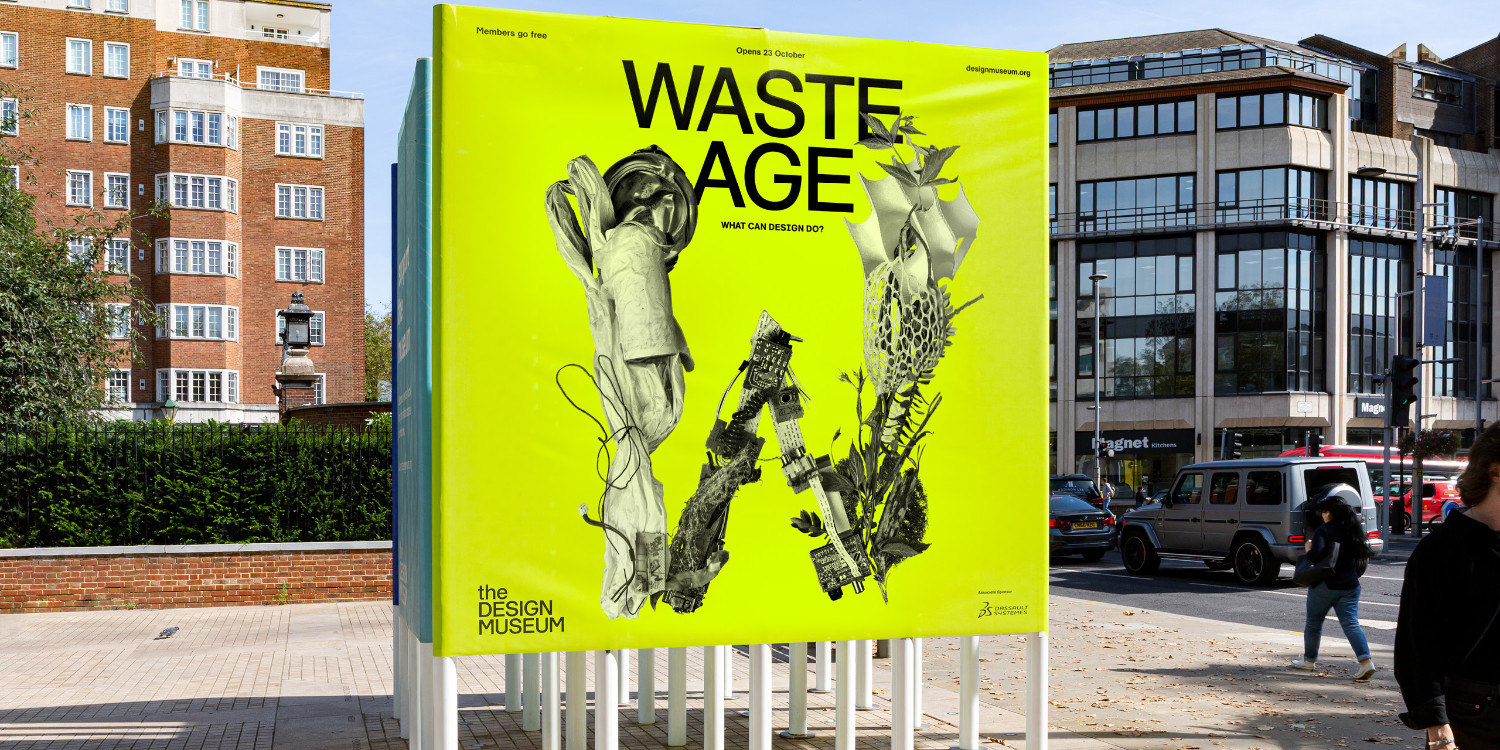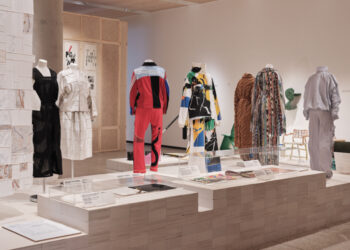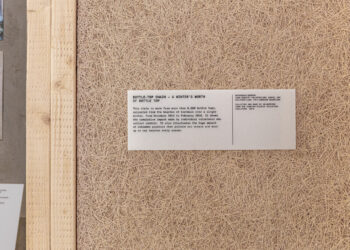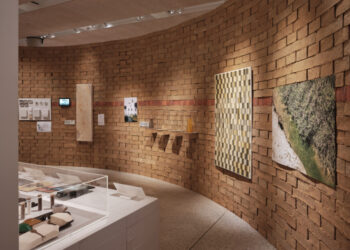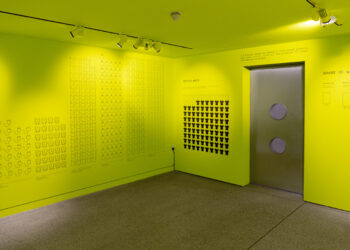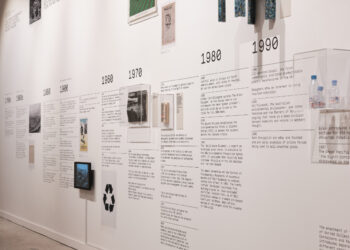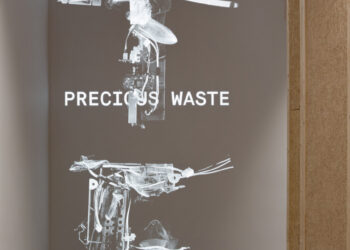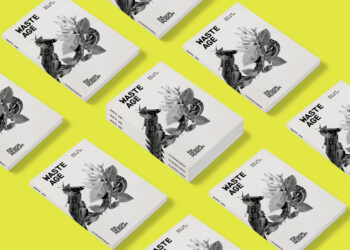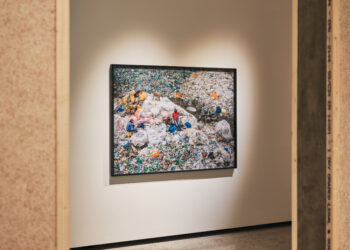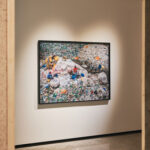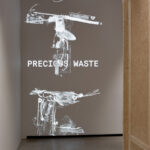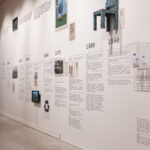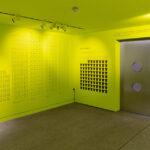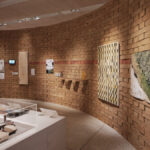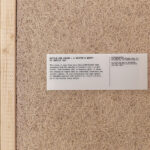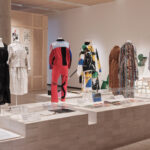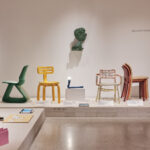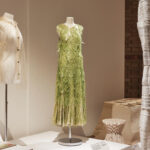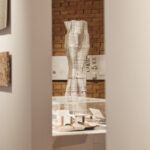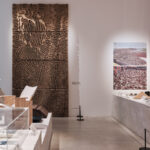Introduction to Waste Age
We are living in an age of waste. The world produces two billion tonnes of rubbish each year, seven times the weight of the world’s adult population. Only 15% of this waste is recycled.
Waste Age: What can design do? – a touring exhibition by the Design Museum, curated by Gemma Curtin and first shown at the Design Museum from October 2021 to February 2022 – tells the story of the environmental crisis created by our ‘take, make and waste’ economy. The exhibition explores how the design industry has contributed to creating our extractive throwaway culture but also how design can – and must – help to find less wasteful ways to live and consume.
While Waste Age asked ‘what can design do?’, it also called for the Design Museum to explore how to reduce waste when creating an exhibition. We were conscious that, as a museum, we are contributing to the waste problem and that the museum sector at large has a lot of work to do to minimise their exhibitions’ environmental impact. Julie’s Bicycle, a non-profit organisation mobilising the arts and culture industries to take action on the climate and ecological crisis, states that the museum sector accounts for almost a quarter of the CO2 equivalent emissions of all Arts Council England NPOs, more than theatre, dance, libraries and other cultural institutions. This arises from practices such as disposing of virgin materials from temporary exhibitions to landfill after the exhibition has closed, shipping objects internationally, and the heavy carbon costs created by this and AV heavy exhibitions that consume large amounts of energy.
Working on Waste Age provided an opportunity to interrogate our practices and reconsider how to approach and design exhibitions to be less wasteful and more environmentally sustainable. It offered a moment for internal reflection and an opportunity for inviting external experts into the process of designing an exhibition, providing analysis of and practical advice on resource use, production methods, supply chains, and lifecycles of all exhibits and materials. This aimed to minimise the waste produced in Waste Age and provide a framework for future exhibitions to build from, creating a longer legacy of the exhibition.
We asked ourselves “what can design do to reduce the environmental impact of exhibitions and museums?”
The brief called for a refreshing innovative approach to the design of a touring exhibition that embeds sustainability at its core.
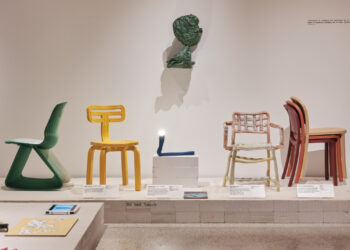
Embedding wastelessness into the design brief
From the earliest stages of appointing 2D and 3D designers to work on the exhibition, we prioritised sustainable, waste-free practices, embedding these criteria into the initial brief that the 2D and 3D design teams received.
The brief called for:
- A refreshing innovative approach to the design of a temporary, and touring exhibition that embeds sustainability at its core.
- Use of the existing exhibition structure and elements and stock from the museum.
- Reusing items from local sources or securing the future re-use of virgin material.
- Above all, an open approach and rationale when other options are taken.
The brief also explained the necessary teamwork and communication that would allow for the development of a less wasteful exhibition design. It states: “The materials, methods used in the build of this exhibition will be scrutinised, the choices made should be transparent, with the aim to have a carefully chosen palette of ethically considered materials.”
After going to tender, we appointed Material Cultures as the 3D design team and SPIN for the 2D design. Both teams used experimental and thoroughly researched approaches, creating new aesthetics and material palettes that celebrated minimising waste and demonstrated the creative opportunities that can arise from working in a more environmentally conscious manner.
A post-waste framework for 3D exhibition design
Material Cultures is an architectural practice and non-profit organisation that was co-founded by Summer Islam, Paloma Gormley and George Massoud with the mission to create a post-carbon built environment. They applied their knowledge of material cycles to develop an exhibition design to counter and critique the wasteful practices of the museum and cultural sectors.
Their proposal and design were based on three key principles:
Reuse wherever possible
In the Waste Hierarchy1, which ranks waste management options from best to worst in terms of their environmental impact, reuse is listed as the second most effective way to minimise waste and is better for the planet than recycling, recovery or disposal. With this in mind, Material Cultures reused the existing interior stud walls from a previous exhibition. They also reused the silicate blocks that were used to construct plinths in the previous exhibition, Charlotte Perriand: The Modern Life, restacking the bricks into new display structures suitable for Waste Age.
Rethinking the material palette
For the new structures within Waste Age – a square timber-based room constructed in a cassette-style and a curved brick wall – Material Cultures replaced carbon-intensive materials that are commonly used in exhibition builds such as MDF with carefully sourced bio-based, low carbon materials that are responsibly and locally produced. These materials absorb and store carbon rather than emit it, drastically reducing the carbon footprint of the exhibition.
The materials included:
- Untreated plywood
- Woodwool panels – made from timber offcuts and waste
- Adobe bricks – made from unfired clay, sand and straw
- Felt – made undyed sheep’s wool
- Clay renders – made with waste materials from the UK brick industry
Design for deconstruction and reuse
The exhibition was designed with the afterlife of each material in mind, prioritising the ease of reuse at the conclusion of the exhibition. Material Cultures used construction methods and joining details that allowed all the elements to be simply dismantled. The timber cassettes were constructed with simple joists and screws and the unfired-clay wall’s shape and thickness were engineered to allow dry stacking rather than mortaring. Focusing on design for disassembly meant that all the elements could be reused for future exhibitions or donated to other organisations.
The elements were used for:
- All wood wool and timber were donated to New Road Group (construction company)
- 800 fired bricks were donated to New Road Group
- Most of the Perspex cases will tour with the exhibition to Paris and the remainder have been given to RCA students
- 250 fired bricks, 10 silicate blocks and 10 adobe bricks were donated to Ella Doran from the Royal College of Art and Urge
- The felt was donated to fashion designer Phoebe English for use in a future collection
- Unfortunately, the remaining bricks were not able to be distributed for reuse due to a last-minute cancellation from the party who had accepted them. This points to the complex logistics of reuse and the need for increased and timely collaboration and communication when trying to minimise waste
Reducing waste through 2D Design elements
SPIN is a London based graphic design studio with over 20 years of experience across a range of projects, including exhibition design and identity. Run by Design Director Jonas, Zieher, Managing Director Patricia Finegan and Creative Director Tony Brook, SPIN’s team used Waste Age as an opportunity to assess the environmental impact of graphic design elements and rethink their material choices and aesthetics in the context of waste. They describe the design as “stripped-back, and therefore informative and visually impactful in a way that conveys the urgency of the message behind Waste Age.”
Their design minimised waste by exploring novel methods of printing and designing including:
Inkjet printing
Throughout the exhibition, SPIN utilised hand-held inkjet printers – usually used for industrial labelling – for wall texts, infographics, quotes, “do not touch” signs, and more. The extensive use of this printer mitigated the need to use vinyl or plastic lettering, greatly reducing material waste. They selected water-based ink to avoid toxic chemicals. The method of printing helped to shape the aesthetics of the typeface which was adjusted to make it clearer when printed with the gun.
Typefaces constructed from found material
For the section headings, SPIN developed an animated typeface from Waste Materials such as plastic bottles and aluminium cans. The largescale typeface aimed to demonstrate how waste can be repurposed to be functionally and aesthetically impactful.
A reduced-waste catalogue
Working with the publishing team at the museum, SPIN worked to minimise the impact of the printed catalogue. It was printed on the world’s first CarbonNeutral© printer, using vegetable-based inks, uncoated and recycled paper stock for the cover and sustainable paper sources for the pages. It was printed in the UK to reduce carbon-intensive shipping impacts and was sold without plastic shrink wrap packaging or other plastic-heavy packaging processes.
Recycled and recyclable captions
The captions were screen printed onto recycled and recyclable plastic. The sturdy material meant that the captions lasted the duration of the exhibition run and did not have to be replaced due to damage.
The audit was undertaken to set a new benchmark for the process of future exhibition and to gain a deeper institutional understanding of how to make a lighter impact on the planet.
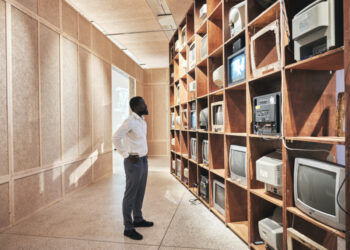
Learning and Assessing through an Environmental Audit
Throughout the development of Waste Age, the exhibition’s team and designers worked with URGE Collective who audited the process and the impact of the exhibition. The audit was undertaken to set a new benchmark for the process of future exhibition and to gain a deeper institutional understanding of how to make a lighter impact on the planet.
Primarily URGE focused on measuring the carbon footprint of the exhibition. They also provided feedback on the design and curatorial decisions in terms of their impacts. URGE’s team gathered insights through a combination of interviews, observation, and data analysis, with the group setting up digital carbon trackers and working with contributors to gather information first-hand from challenging and complex supply chains.
URGE gathered data on:
Exhibits – weight/distance and type of transport
Emails/video calls – numbers sent and received across the whole team
Materials and processes – Exhibition design and production/build and graphic design and production
Key Findings of the audit
The audit revealed that the total exhibition impact was approximately 21.2 tons of CO2e (CO2 equivalent). The Co2e emissions were the result of:
Building energy:
Energy supply is the most important step in reducing emissions. If the Design Museum used the national average electricity, the impact of the exhibition would be about 185 tons of CO2e. The museum’s use of renewable energy cut the total impact by about 95%.
Exhibits:
The objects weigh roughly 500kg, and the average distance they travelled was 1,100km (many are from London) thus the logistics footprint is less than 20kg CO2e.
Commissions:
the Fadama 40 exhibit single-handedly doubled the exhibition’s carbon footprint, chiefly because of the materials and transport choices involved (i.e. large amount of copper & air freight of one component of the installation).
Exhibition build:
The highest build impact is the screws. Using 4,800 standard stainless steel decking screws has an impact of 1.9 tons of CO2e – roughly 20% of the total exhibition footprint. URGE recommended minimizing the CO2e impact of this surprising find by reclaiming and reusing the screws after the exhibition.
Using a timber frame system over a standard aluminium exhibition frame system saved 1.5 tons of CO2e, reducing the impact by about two thirds.
Using unfired bricks instead of fired bricks saved 6 tons of CO2e, the second most significant saving after switching to renewable electricity.
Digital communication:
Up to 10% of the total footprint is associated with digital communication
Emails: approximately 11,000 emails and 11GB of data have been shared, which equates to around 1 ton of CO2e.
Video calls: approximately 750 person-hours were spent on video calls. The impact of this is less than 0.5% of the total footprint.
total exhibition impact: approximately 10 tons CO2e – 80% of which is in the build.
Key Learnings for the museum
Chase data:
Gathering detailed information and following up with suppliers throughout the audit helped the Design Museum make informed decisions. It challenged assumptions and showed that some unexpected options – such as using recycled plastic for exhibition captions – had the lowest impact.
Challenge convention:
Both the 3D design and audit processes encouraged the Design Museum to question accepted methods of planning and building exhibitions. Sustainability isn’t something that is achieved instantly, but the more alternatives are explored, the more viable and genuinely impactful options are found.
Work together:
Only the expertise of many specialists made this process possible. Communication between Museum departments revealed how making changes can have knock-on effects, so the Design Museum aims to increase this collaboration across the organisation in future.
Use renewable energy for electricity supply:
The Design Museum had already converted to renewable energy before Waste Age. However, the auditing process allowed for a deeper understanding of the positive impact of this change and will help to drive future decisions about the building and its energy use.
Select low impact construction materials for the build and commissions:
Low impact materials which are sourced locally will have the least environmental impact. If material needs to be shipped, lightweight and carbon-negative or neutral materials should be prioritised.
Source projects locally wherever possible:
This avoids carbon-intensive shipping and mitigates the need for air travel as part of the procurement process. Waste Age’s curators chose not to fly at all – partly due to COVID-19 – and exhibitors used video links rather than sending couriers to oversee installations.
Count digital carbon:
Making up 10% of the exhibition’s total impact so far, the surprisingly high emissions created by video calls, websites, emails and attachments were exposed by the audit’s carbon tracker.
Be open to learning and resource staff and time to make this possible:
The Design Museum’s construction and installation teams went through a learning process of working with unfamiliar materials, such as walls of self-weighted bricks, which posed new challenges. This meant that more time and resources were needed for sourcing and understanding materials. One unanticipated benefit of using bio-based materials was that they did not dramatically increase in cost in line with other more conventional building materials in 2021. This meant that the materials budget was adhered to at a time when other exhibitions were challenged with rising material costs due to high demand and post-Brexit taxes and shipping costs.
The process will not be perfect:
Working to minimise waste and lower carbon footprints is a complex undertaking, especially within the constraints of tight deadlines and working to budgets. While Waste Age was a big step forward in the approach of the Design Museum the museum’s team are still learning how to minimise impact and some decisions could have been made differently. Waste Age provided a benchmark to build from in the future rather than a perfect blueprint for an exhibition.
Share knowledge and resources:
The museum sector has a lot to learn and change to reduce its impact and sharing knowledge and resources is key to expediting these urgently needed changes. Internally, the exhibition’s team has shared the learnings of Waste Age through discussion with colleagues, circulating the audit findings and creating best practice documents which can help future exhibitions to build on this knowledge and reduce their impact. Externally, the Design Museum has offered advice to other institutions, loaned the printing guns to galleries and designers and shared their learnings through articles, talks and interviews.
Exhibition mentioned
Waste Age: What can design do?, by the Design Museum
1 Department for Environment Food and Rural Affairs. (2011, juin). Guidance on applying the Waste Hierarchy. https://assets.publishing.service.gov.uk/government/uploads/system/uploads/attachment_data/file/69403/pb13530-waste-hierarchy-guidance.pdf

